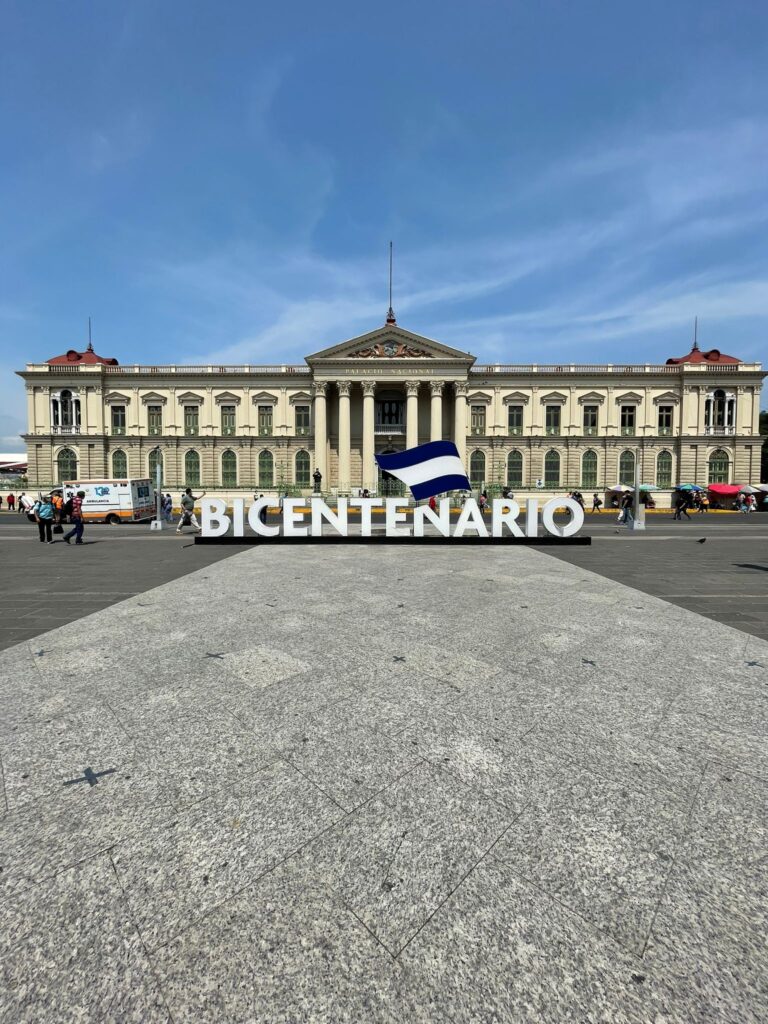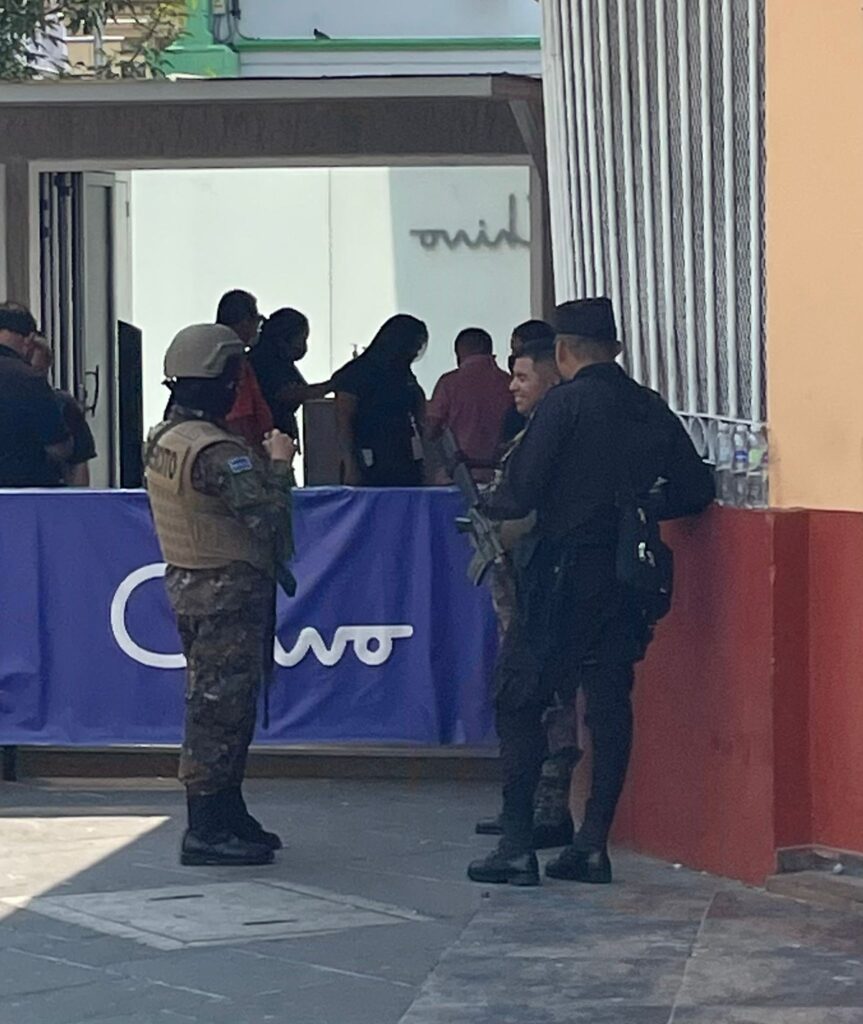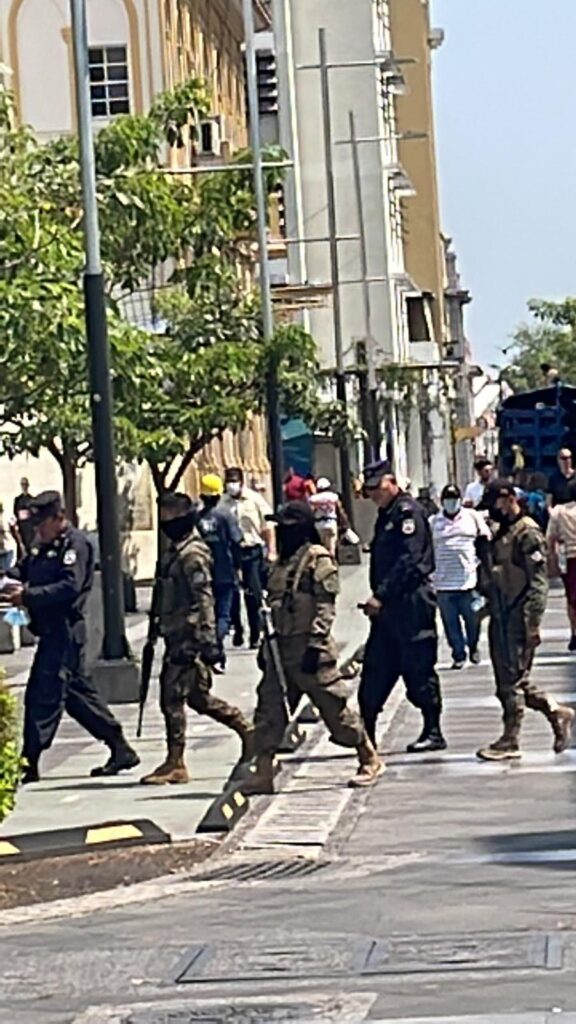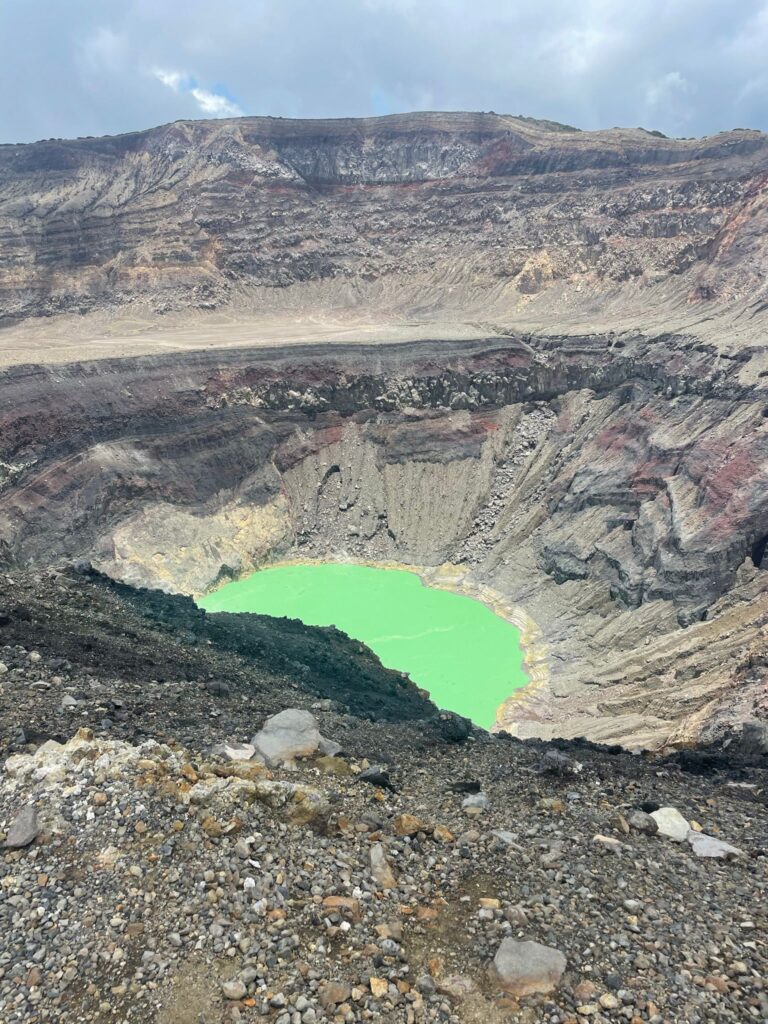Is El Salvador Safe for Tourists?
El Salvador is safe for tourists in 2024. In fact it is now one of the safest countries in the Americas, largely thanks to a major crackdown on gang crime since 2022 under popular president Nayib Bukele.
I visited El Salvador just two weeks after 62 murders occurred on a single day – Saturday March 26th 2022. This was the catalyst for the Salvadoran gang crackdown which completely transformed this former no-go zone.
I will explain the safety situation in El Salvador below, covering topics such as why it is seen as dangerous, what it is like now, and what the main dangers in the country are these days.

Why do People Think El Salvador is Dangerous?
El Salvador was home to a major gang war between two pretty awful groups of people, known as Mara Salvatrucha (MS-13) and Calle 18 (The 18th Street Gang).
These two groups would kill each other, and anyone who tried to stop them (police, government etc.) as well as innocent civilians who refused to pay protection money.
The violence was so awful that an astonishing 20,000 people were killed between 2014 and 2017.
Past attempts to halt it ended in failure. Most notably the 2012 gang truce brokered by the Salvadoran government which had brief success, but fell apart due to politics and disagreements with the gangs feeling they weren’t getting a good deal.
As the old US-inspired cliche goes, “we do not negotiate with terrorists”. And sure enough, the same applies to violent street gangs. People were unhappy that politicians were making deals with murderers rather than locking them up.
And so, the violence continued.
The number of homicides per year in El Salvador were as follows:
| Year | Number of homicides per 100,000 people |
|---|---|
| 2014 | 68.6 |
| 2015 | 103 |
| 2016 | 81.2 |
| 2017 | 60 |
| 2018 | 51 |
| 2019 (Bukele elected) | 36 |
| 2020 (Covid restrictions began) | 19.7 |
| 2021 (Covid restrictions relaxed) | 17.6 |
| 2022 (Gang crackdown began) | 7.8 |
| 2023 | 2.4 |
Is El Salvador Safe for Tourists in 2024?
El Salvador is very safe for tourists now, and it’s a great country to visit, so don’t be deterred by past problems!
Let’s have a look at just how safe El Salvador has become, compared to other countries.
Whilst we don’t currently have 2024 data available, if we look at the 2022 murder rates from across the world, we can see that not a single country had more homicides than 2014-2017 El Salvador, which gives you a fair idea as to why the country is viewed as dangerous. That despite it being an outdated perception now.
It is worth noting that only 71 countries/territories had data recorded for them in these statistics. Although it still gives a good idea of which countries had a high murder risk.
| Ranking | Country | Murder rate per 100,000 people (2022) |
|---|---|---|
| 1 | Jamaica | 53.34 |
| 2 | St Vincent and the Grenadines | 40.41 |
| 3 | Trinidad and Tobago | 39.52 |
| 14 | Costa Rica | 12.82 |
| 17 | Uruguay | 11.19 |
| 19 | 2022 El Salvador | 7.83 |
| 24 | USA | 6.38 |
| 30 | Latvia | 3.62 |
| – | 2023 El Salvador | 2.4 |
| 34 | Canada | 2.27 |
| 71 (last) | Singapore | 0.26 |
The countries I selected in this table are not random. The top three (Jamaica, St Vincent and the Grenadines and Trinidad and Tobago) are the three countries with the highest murder rates as per these statistics.
Costa Rica and Uruguay were selected as these are widely believed to be the safest countries to visit in Latin America, and therefore a good point of comparison for fellow Latin country El Salvador.
The USA was the first major western country to feature, Latvia is a notoriously safe country in Eastern Europe’s Baltic region, and Canada is famous for scoring high on “safest country in the world” lists. Thus explaining their inclusion in this data.
Lastly, Singapore was the country with the lowest murder rate as per this data. It is the safest country in Southeast Asia as well as being one of the safest (arguably THE safest) in the world.
As you can see, El Salvador is sliding down the murder rankings with a remarkable 98% drop in homicides from 2015 to 2023.
With a decrease for 8 consecutive years, trends would suggest 2024 data will show El Salvador to be even safer than it was in 2023.
There has never been a better time to visit this wonderful country. Except for maybe next year!
Why is El Salvador Safe Now?
El Salvador is safe because of a massive gang crackdown by president Bukele which began in March 2022.
He announced a state of emergency giving powers to arrest suspected gang members and restrict their access to lawyers.
Human rights groups have criticised this policy, claiming innocent people have been caught up and arrested under the incorrect assumption of being gang members. Indeed, the Associated Press reported in September 2023 that over 7,000 people were released from 72,000 arrested due to a lack of evidence of gang links.
However, the statistics speak for themselves. And locals have nothing but good things to say about Bukele who was reelected in February 2024 with over 85% of votes.
Everyone I met in El Salvador spoke glowingly of Bukele’s gang crackdown. And this was right at the very beginning, literally a couple of weeks after it had begun.
The limited results at this point in time (April 2022) didn’t deter people from praising the crackdown as a roaring success. And based on what I heard from Salvadorans from all walks of life, the only surprise with his eventual reelection was that he “only” received 85% of the votes.
I’ve never known people in a democratic country to speak so overwhelmingly positively about a single politician.
I will be going back to El Salvador in the near future.
When I went in 2022 I spent hours researching danger in the country and how to avoid it. Now I would put it in the Costa Rica/Uruguay bracket as the safest country in the region.

What do Travel Advisories Say About Visiting El Salvador?
When people go abroad, they tend to turn to government travel advisories for safety information on a country.
I get it. A formal government website appears to be a form of authority, and therefore people trust it more than “Adventure to Every Country” or other blogs out there.
I say, take travel advisories with a pinch of salt. They are (understandably) overly cautious. They are also often slow to update information.
For example, Ecuador was listed as being very safe on the UK government website in June 2022 shortly before I went there. In reality it faced weeks of disruptive protests and riots which shut down transport links within the country.
The UK government website took weeks to update on this information and put it down as an amber country (do not travel unless it’s essential). It took a week after the issues cleared up, to state Ecuador was safe to visit smoothly once again.
My advice: government travel advisories are best for information on visas and entry requirements. They are a useful tool for baseline safety knowledge, but you will get far better information from locals and recent travellers to a country.
Advisories will overstate threats to cover themselves in case an issue does occur. It’s a PR exercise really, and I get it, but it does mean they aren’t the best source of safety info.
I recommend the Facebook group “Every Passport Stamp” which is where serious travellers specialising in travel to difficult destinations share up-to-date information on the places most government sites and media outlets advise against visiting.
Social media is a great tool for finding up-to-date safety advice, and other important information.
I also recommend finding Facebook groups specific to your chosen destination.
Let’s have a look at some travel advisories on El Salvador:
United States
The USA says El Salvador is a level 3 (out of 4) country: “reconsider travel”. They claim that violent crime remains a significant threat across the country.
This is simply not true.
Does violent crime still occur in El Salvador? Yes, just like it does in Singapore, Japan and Iceland for example (some of the world’s safest countries).
In reality, the crime threat is low. Some basic common sense precautions (don’t get your phone out in the streets or walk around on your own at night for example) are all you need here.
The US overstates the danger in El Salvador and offers a poor representation of the country in its current state.
United Kingdom
The UK does at least give a more toned-down version of the situation. It correctly mentions that gang violence rarely has any impact on tourists, and that violent attacks (gang related or otherwise) on visitors are isolated.
It also acknowledges the progress that has been made since the crackdown.
As I mentioned above, government advisories are not necessarily a great source of information. However I would say the UK’s advice as of June 2024 is fair and reasonable.
Australia
Like the UK, Australia also gives a fair representation of the situation as of June 2024.
They do state that visiting El Salvador requires a high degree of caution. This is the second level out of four on their ranking system, putting it on a par with Germany, France, the UK, the UAE and Costa Rica at the time of writing.
Australia does say that it’s possible to be a victim of gang crime, but that could be the case anywhere.
“It’s possible” is true in any country, and not to be confused with “it’s likely”.
They also rightly say you should take more precautions at night, although this is wise in any country.
Canada
Canada has also jumped on the trend of categorising countries in one of four levels, putting El Salvador on the second level “exercise a high degree of caution”.
Again, it lists El Salvador in the same bracket as those popular western countries (France, Germany, UK etc.) that you wouldn’t think twice about visiting from a safety perspective.
Canada follows the US in writing scary things such as “armed robberies occur with weapons such as guns and knives, especially on public transportation. Robberies by thieves on motorcycles occur.”
Can this happen? Yes. But is it really any more likely than in the US? Not really. The only difference with armed robberies in El Salvador is that they are indeed more likely to be carried out by criminals on motorbikes.
This is a trend across much of Latin America and I have friends who have been targeted in this manner (in Chile, not El Salvador).
My tip would be to avoid using your phone on the street and only touch it if you enter a cafe or shop first. This is a general safety tip across my beloved Latam and not specific to El Salvador.
What About the Capital, is San Salvador Safe?
San Salvador is very safe for tourists to visit, in fact it is one of the safest capital cities in Central America these days.
Of course petty crime still exists, as it does in almost every city across the world, safe and dangerous alike. However, the chances of stumbling into gang violence are almost non-existent in modern times.
During my first trip to San Salvador in April 2022, I was just passing through on my way between Santa Ana and the famous beaches of El Tunco and El Zonte.
I was alarmed as one of the first things I saw in the capital was a man with his face covered in tattoos. I decided against staring long enough to see what they said, but facial tattoos are often a sign of gang membership here. Mostly notably the letters MS (MS-13) and the number 18 (18th Street Gang).
Nothing happened, however this may well have been one of the deadly gangsters that plagued the country for so long. Your humble Salvadorian security guard or lady making pupusas on the street will not have facial tattoos…
In fact tattoos are fairly taboo in El Salvador thanks to their gang links, similarly to how they are in Japan due to links with Yakuza gangs.
I went back to San Salvador a few days later to spend some time in the city. It was incredibly safe.
The historical city centre (Centro Historico de San Salvador) is where you want to go for a more local feel.
This is where the majority of colonial and cultural buildings can be found. Pupusas are in no short supply here, whilst you can even get a cheap haircut, just as I did around Liberty Plaza. And it turned out to be one of the better haircuts I’ve had!
You will only see a handful of western tourists around here. Which is a shame, because this part of the capital is safe and showcases “the real San Salvador”.
On the other side, you have the western side of San Salvador which is essentially a different world from the traditional centre. It is full of major shopping malls that look more like what you would expect in the US rather than Central America.
Unlike in more rugged parts of the Americas, San Salvador has everything you could possibly need. It’s a city I’d recommend for both living in and visiting alike.
Outside of the popular spots to visit, you had some notorious gang hotspots with no reason for tourists to ever explore. One of these was Soyapango.
Today, locals from Soyapango speak of how the neighbourhood is unrecognisable from the violent days when crossing the road into rival gang territory could be a fatal mistake.
Whilst I wouldn’t recommend a trip to Soyapango, a place with nothing of interest, it’s no longer the deathwish it once was. And it goes to show that even the darkest corners of the capital aren’t total no-go zones as they were in the very recent past.
San Salvador has many Soyapango-style neighbourhoods which are unrecognisable from the lows of pre-2022.

What are the Main Dangers in El Salvador Today?
Whilst most people’s perceptions of danger in El Salvador revolve around violent crime, there are other issues that are more likely to ruin your trip. Let’s have a look at them here.
Tropical Diseases
With a tropical climate and temperatures averaging around the 25 degree mark throughout the year, El Salvador is prone to some of the diseases that come with this territory.
The good news is that the World Health Organisation declared El Salvador is being malaria-free in 2021. It also has no problems with yellow fever, although you will need vaccinations if coming from a yellow fever risk country. The risk countries are Panama, Trinidad and Tobago, and several countries in Africa and South America.
The bad news is that the likes of dengue fever, Zika virus and various tick-borne illnesses are present in the country. Speak to a travel health expert to find out how to avoid these. But wearing DEET spray, wearing long sleeves and using mosquito nets whilst sleeping are always a good starting point.
Natural Disasters
Now one area in which El Salvador can be hit hard is with natural disasters.
Volcanos
For starters, there is volcanic activity within the country. Whilst not frequent, deadly eruptions can occur and have done in recent years.
Popular Santa Ana Volcano, which I would recommend putting on your bucket list as an excellent hike, erupted in 2005 killing at least two people, whilst San Miguel Volcano displayed seismic activity in January 2023, although no one was harmed.
It should be noted however, that despite being in the Pacific Ring of Fire, the risk of a volcanic eruption in El Salvador is very low and should not have an impact on your travel plans.
Flooding
Perhaps more of a concern is flooding.
Some areas of the country are prone to heavy flooding, particularly during the rainy season from June-October.
Travel insurance giant World Nomads reports that landslides are a threat in mountainous areas during the wet season, and they have been known to claim lives.
In fact, I discovered that heavy rains killed 11 in El Salvador just days before I finished writing this post.
Hurricanes
On top of flooding, the rainy season also brings hurricanes in Central America.
Tropical storms can escalate and become hurricanes which become a threat to both people and property as they approach land.
Be sure to monitor local media for updates on potential hurricanes. Seek consular assistance if you are caught up in one and require medical attention, or help leaving the country.
Earthquakes
The Pacific Ring of Fire makes countries prone to earthquakes as well as volcanic eruptions. And sure enough, that’s the case with El Salvador.
There have been seven earthquakes in the past century which have killed 100+ people, including two a month apart in 2001.
The good news is that there haven’t been any major quakes since then, at least not in terms of deaths and injuries.
Again, don’t let scary words such as “earthquake” put you off visiting El Salvador. The risk is very low.
To give you an idea of risk levels, I was in Japan a few months back as a major earthquake struck the country, with tsunamis expected afterwards.
This series of tremors became the top news story around the world at the time. And us? We didn’t even know about it for several hours!
My point being, that even in a country prone to such disasters, they often hit only a tiny fraction of the nation and most people will remain unaffected.

Are There Any Other Dangers to be Aware of in El Salvador?
To be honest, that’s about it. Unlike in some countries, El Salvador’s drivers are relatively safe.
And whilst there is dangerous wildlife in the country, it’s not a major threat. Yes, you should be cautious and aware of dangerous snakes existing, but the chances of running into one are super slim.
Stick to the tourist areas and you will almost certainly have no issues travelling through the country.
Final Thoughts on El Salvador
El Salvador is VERY safe for tourists. In fact it’s a contender to be named one of the safest countries in the Americas these days.
But being safe is one thing, being interesting is another. After all, Kuwait is incredibly safe, but it’s also dead boring, so there aren’t many good reasons for a tourist to go there.
El Salvador doesn’t have this issue. It is one of the best countries in Central America for cool things to see and do.
I started in the awesome colonial city Santa Ana, and found this to be a great way to ease myself into El Salvador. I don’t recall seeing any other foreigners there.
I was able to walk around the streets, check out the markets and get to know first hand just how friendly the Salvadoran people are.
Most people only speak Spanish there, but Google Translate has some helpful features which can help if you aren’t yet fluent in español.
Arguably the highlight was Santa Ana Volcano with its awesome turquoise crater pool at the top, and surrounding Coatepeque Lake.
As mentioned earlier, still informed through local media about potential eruptions when hiking up volcanos. They are rare so don’t let fear put you off this beautiful spot.
My next stop was the beaches of El Tunco, El Zonte and El Sunzal. I wasn’t a fan of any in all honesty, but then again I wasn’t the target audience for any of these spots.
El Tunco is a surfer’s paradise. I’ve only heard good things from people who surf there (I’m not a surfer and therefore didn’t do this).
El Zonte is known as “Bitcoin Beach”. It became famous as a world leader in trying to develop a Bitcoin-based economy. It’s currently very underdeveloped, but this could be a place to watch in the future.
El Sunzal is between its two larger neighbours. It’s got nothing of interest really and I was only there because it was where my (awful) hostel was located. Skip it.
Last up was the capital San Salvador. I touched on this earlier, and it’s awesome to visit both the historical centre for some local culture and traditions, as well as the more modern western side of the city.
One thing I didn’t mention was El Boqueron. Also known as San Salvador Volcano, you can get an Uber right to the top where you can look down at the crater. It’s a cool place to see for a couple of hours or less.
Overall, I would strongly advise putting El Salvador on your itinerary. They have a saying “don’t skip El Salvador”, which came into existence as many Central America backpackers would head straight between the country’s two larger neighbours, Guatemala and Honduras.
I would have to agree with that slogan.
Don’t skip El Salvador!
